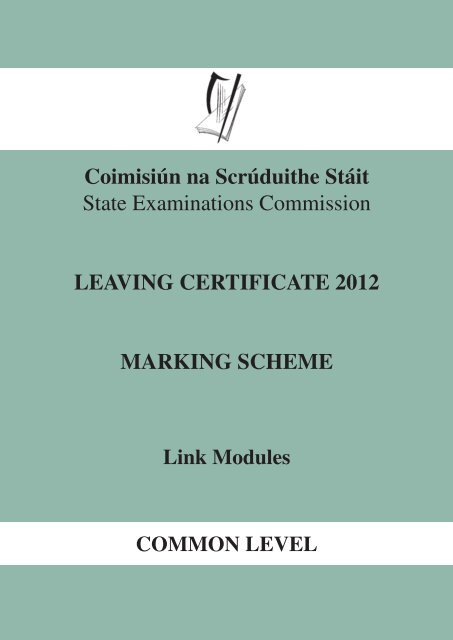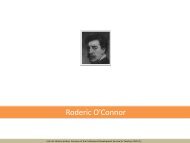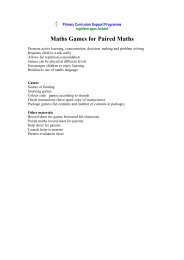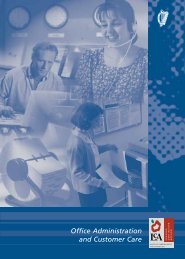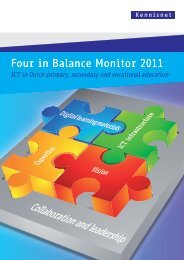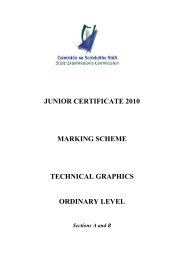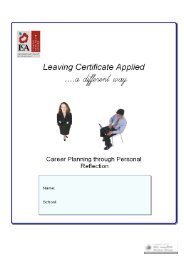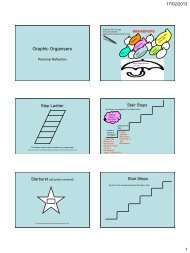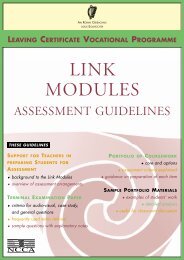Marking Scheme - Examinations.ie
Marking Scheme - Examinations.ie
Marking Scheme - Examinations.ie
- No tags were found...
Create successful ePaper yourself
Turn your PDF publications into a flip-book with our unique Google optimized e-Paper software.
Coimisiún na Scrúduithe StáitState <strong>Examinations</strong> CommissionLEAVING Leaving CERTIFICATE Certificate 2012 2012MARKING <strong>Marking</strong> <strong>Scheme</strong> SCHEMEDesign and Communication Link Modules GraphicsCOMMON Higher Level LEVEL
LCVPLink Modules Examination2012Solution and <strong>Marking</strong> <strong>Scheme</strong>Written ExaminationExamination Total marks 160Distinction 128 marksMeritPass104 marks80 marks
Q.6 What could Dermot have done to reduce Tom’s stress levels on this particular project? 4 marksPart 31. He should have regular meetings from the beginning of the project to make sure that everyone isclear on all aspects of the job.2. He could have provided proper IT training from the outset + valid expansion.3. He should have made sure the schedule was more realistic + valid expansion.4. Proper planning at the beginning would have meant revisions would be kept to a minimum.2 @ 2m(1 + 1)Q.7 Why is it necessary for managers like Dermot to have good communication skills? Explain youranswer.6 marks1. Because he has to deal with lots of different people, eg line workers, supervisors,cl<strong>ie</strong>nts. Healso-need to control and manage teams on site.2. He has to deal with employee issues such as: conflicts, individuals whose work may be belowstandard.3. As a manager he must appear confident in order to show his authority.4. He needs to talk to his workers, become aware of problems before they get out of control/affectthe work being done.5. He needs to listen to his workers, to tap into the expertise of the workforce, identify trainingneeds.3 @ 2m(1 + 1)Q.8 Dermot has shown a good aptitude/ability for managment. Do you agree with this statement? Explainyour answer.6 marks1. He is good at self reflection, admits his own faults e.g bad scheduling.2. He recognised the value of good employees such as Tom.3. He has concern for his cl<strong>ie</strong>nts. He listens to cl<strong>ie</strong>nts and is anxious to keep them informed andup to date with developments on site so that they are not concerned.4. He is good at his job, he has a calm manner,he kept written notes and documentation on thecomplaints against Tom. He is pleasant but firm.5. He has good problem solving skills/deals with problems.*Candidates may also present a ‘No’ answer.3 @ 2m(1 + 1)4
Section B Case Study 30 marksQ.1 Explain the benefits the community resource centre will bring to the people of Glencar.6 Marks1. It is a good facility for community groups, crèche, clubs, and local organisations to meet.2. It provides a social outlet for retired groups, young and older people.3. It could encourage a good community/entrepreneurial spirit in the area.4. It may encourage the setting up of new clubs.5. The resource centre/seasonal tourist office will benefit many local businesses/spin offbusiness/indirect employment- cafes, tourist attractions, B & B’s and hotels.6. Provide employment in the centre/direct employment.7. Provides training/up skilling.3 @ 2marks(1m for stating + 1m for description)Q.2(i)(ii)Outline two reasons why the County Council wants people from local community and businessgroups to participate in the resource centre committee.Explain why it is important that the committee carr<strong>ie</strong>d out market research before devising itsplan.(iii) Select one of the community needs identif<strong>ie</strong>d in the survey. What are the implications for thecommittee if they decide to provide the service?12 marks(i)1. The County Council needs to know what the local community and business groups want fromthe centre/involve them in making decisions about the development.2. The large range of skills and talents within these groups will benefit the committee/costsreduced due to services provided by local people.3. Business people have the business management and finance skills needed to ensure the successof the project.4. Business groups may invest in the development of the centre/may sponsor activit<strong>ie</strong>s in thecentre/boost public relations.5. Generates a better community spirit because if local people are involved from the outset theywill be more positive about the community centre and their involvement/running of the centre.2 @ 2 marks(1 + 1)(ii)1. To identify the needs of different groups in soc<strong>ie</strong>ty so that they can focus their planning.2. Make sure money is not wasted in providing services not demanded/already provided in thelocal area.3. Consulting local people shows that their opinions matter and they are more likely to supportcentre when it is operational.2 @ 2marks(1 + 1)5
(iii)Select a need.Implications for the committee of this choice.Valid implication to the need is required.CrecheTrained staff are required.Specialist equipment may be needed.There are Health & Safety concerns.Youth Club/CafeHow will the youth club/cafe be staffed e.g.volunteers or paid staff.What age group will the club/cafe serve?There may be food hyg<strong>ie</strong>ne issues or Health & Safety requirements.Specialist equipment may be needed.2 marks2 @ 1mRetirement GroupThe garden will need maintenance.Computers will have to be provided and staff to teach IT skills may be required.The committee may have to decide on a var<strong>ie</strong>ty of uses such as bowling, cards etc.Meeting/training facilit<strong>ie</strong>s:Internet access will have to be provided.Equipment for meetings such as desks, chairs will be required.IT equipment e.g. computers, data projectors will be needed.Free parking and easy access to the building will be needed.Refreshments facilit<strong>ie</strong>s are necessary for such a facility.The committee will receive revenue by using the centre in this way.Recreational:Different size rooms may be needed depending on the use.Should a full time manager be employed? The committee may decide that rooms can be hiredby local groups.Shower facilit<strong>ie</strong>s may be needed if sports activit<strong>ie</strong>s are planned.The committee will need to determine the opening hours of the centre e.g. evenings andweekends.6
Q.3(i)(ii)What are the benefits for the local community of using the FAS CES.Set out the Finance Section of the Development Plan for Glencar resource centre, covering theinitial set up and subsequent running of the centre.12 marks(i) 1. Local people who are unemployed can get employment/alleviate social problems.2. The committee can save money by using these workers as their wages are paid by FÁS.3. This type of work might suit those who want to work part-time and remain in their localarea.4. The committee can avail of different types of workers.5. Local people are trained/upskilled.6. Community spirit created. Locals are seen working on the project.3 @ 1m(ii)1. Set up the Finance sub-committee:Appoint a treasurer, decide who signs cheques etc.2. Banking – Open a bank account/take out a loan.Decide which bank to use, decide on the type of account e.g.deposit, current account etc.3. Apply for grants/CESResearch what grants are available and how to apply. The finance committee need toestablish what information is required in order to get Lotto funding.4. FundraisingHow it will be done, when it will happen and who will be in charg? How much will beraised and what will it be used for e.g. Capital costs or Current/running costs.5. Budgeted start up costs:Layout design and who will carry out this work. Renovation costs, materials andfurnishings6. Budgeted daily running expenses of centreStaffing costs, heating & lighting, cleaning & maintenance need to be estimated.7. Estimate income that can be generated from clubs,Estimating how much revenue can be earned from charging for meeting rooms. Identifyany other sources of revenue.9 marks3 @ 3m(1 + 1 + 1)2 points on set up + 1 on runningOr2 points on running + 1 on set upNo repetition of points7
Section C General Questions 100 marksQ.1 (a) Name four other ways jobs can be advertised. 4 marks1. Internet/websites2. Recruitment agenc<strong>ie</strong>s3. Job fairs4. FAS training centres/offices5. Notice board in shops/business/Billboard6. Radio7. TV8. Magazines4 @ 1m(b) (i)(ii)(i)(ii)Explain why Newsradio is seeking an employee with good interpersonal skills.Explain why applicants are asked to submit references or name referees on their CV.4 marksGood interpersonal skills are important as the employee will be dealing with andcommunicating with different types of people and customers.Employees must work well with others and work well as part of a team.2 @ 1mReferences are used to check the reliability of the potential employee/the quality of theirwork, suitability for the job etc/Referees provide vital information for a potentialemployer/verify that details given are correct2@1m(c) Write the letter of application for the position advertised. 9 MarksSender’s address1mAddresseeDate 1m Spelling 1mOpening- Dear..} 1m Grammar 1mClosing- Yours..}Layout/Neatness 1mRE:/Reason why they are writing 1mStatement1mEnclose CV1m8
(d)Describe how to leave a lasting impression at an interv<strong>ie</strong>w in order to improve your chances ofsuccess.8 Marks1. Turn up on time/be punctual.2. Neat dress, portray a professional image/dressed appropriately/well groomed.3. Be well prepared/know the facts about the company/rev<strong>ie</strong>w your CV/show that researchon the job has been done.4. Portray positive body language/shake hands/sit correctly/make eye contact/be courteous.5. Speak clearly and slowly to ensure that the interv<strong>ie</strong>wer hears and understands all youranswers. Appear confident.6. Answer all the questions asked, ask for clarification if you do not understand what is beingasked/have a intelligent question prepared.4 @2 m(1 + 1)Q.2 Volunteering is the practice of people working on behalf of others or a particular cause withoutpayment for their time or service.(a)Outline the reasons why people volunteer for community/charity organisations.4 marks1. They want to make a difference and contribute to the community or soc<strong>ie</strong>ty/provide betteramenit<strong>ie</strong>s/services for a group of people/improve life for a group of people.2. People want to do something positive with their freetime/unemployment.3. It can improve personal skills.4. Individuals might want to take on a personal challenge or improve self esteem/personalsatisfaction/Gaisce.5. Family members may have benefited from this organisation.6. Can improve CV/gain exper<strong>ie</strong>nce.7. Social aspect/meeting new people/making fr<strong>ie</strong>nds.2 @ 2m(1 + 1)(b)State and explain the responsibilit<strong>ie</strong>s a volunteer has towards the community/charityorganisation.6 marks1. To respect the aims and values of the organisation. To behave at all times to uphold thesevalues2. To be committed to the work and do the work to a high standard/fundraising.3. To attend all training sessions and put information received into practice at work.4. To respect the confidentiality of the cl<strong>ie</strong>nts of the organisation.5. Treat members/cl<strong>ie</strong>nts with respect and dignity.6. Work well with other volunteers/team members.7. Be trustworthy/reliable/punctual/dependable.Relevant valid expansion required3 @ 2m(1 + 1)9
(c)(d)Describe the issues the community/charity organisation must consider before recruitingvolunteers.6 marks1. Have they proper polic<strong>ie</strong>s, procedures and job descriptions in place?2. Have they correct vetting procedures in place and who checks this?3. They must provide proper insurance cover and safe working conditions.4. They must ensure that there is adequate supervision, support/training and resources forvolunteers.5. What areas/jobs are the volunteers needed for and the skill set requires/numbers required.3 @ 2m(1 + 1)Describe how the community/charity organisation can evaluate the success of its use ofvolunteers.9 marks1. Rev<strong>ie</strong>w if the aims of organisation are being met e.g. are the needs of the organisationbeing met by the volunteers/is the organisation run effectively. They can check the levelof volunteer involvement.2. Check the retention level of volunteers. Do volunteers stay for a long-term and do theyremain loyal to the organisation?3. Survey the volunteers and see if they are satisif<strong>ie</strong>d with the work and feel valued by themanagement of the organisation. Ascertain whether or not they feel supported andwhether they are benefiting from volunteering for the organisation.4. Have a group discussion of volunteers so that everyone can contribute. Ensure theiropinions and feedback are spontaneous and honest.5. Survey the cl<strong>ie</strong>nts/local community; are their cl<strong>ie</strong>nts satisf<strong>ie</strong>d with the services provided?What would they change?3 @ 3m(1 + 2)Q.3 Teamwork is a major feature of modern working life as well as most LCVP activit<strong>ie</strong>s.(a) Name one LCVP team activity you were involved with. 1 markAny relevant activity.1m(b) Outline three benefits of teamwork in this LCVP activity. 6 marks1. Goals are ach<strong>ie</strong>ved faster and the work is shared/more work is done.2. Decisions can be made or problems solved more quickly.3. The responsibility is shared so no one person is under too much pressure/everyone takesownership of the part of the task they are responsible for.4. Members of a team will have a var<strong>ie</strong>ty of strengths/skills or ideas/ Exper<strong>ie</strong>nce, skillsshared/more ideas.5. Disputes are avoided as communication is essential in team work/everyone has a say.6. Pupils can work closely with those who have a common interest.7. Communication/interpersonal skills are improved.8. Pupils are more contented, as relationships with class members improve, bettermotivation.3 @ 2m(1 + 1)10
(c) Describe the characteristics of a successful team. 8 marks1. There are a range of talents or strengths/they should be versitile.2. All members are very committed to a common goal/self motivated to ach<strong>ie</strong>ve/planning.3. The roles and responsibilit<strong>ie</strong>s of team members are clearly defined.4. All ideas and opinions are heard and valued/tolerate others v<strong>ie</strong>ws.5. There is trust and cooperation between team members and there is a good atmosphere.6. There is a strong leader to motivate and support all team members/sucess is recognised.7. There is regular communication/consultation between team members/problem solving.4 @ 2m(0, 2)(d) (i) State and explain the difficult<strong>ie</strong>s/challenges associated with teamwork(ii) Outline how these difficult<strong>ie</strong>s/challenges may be overcome. 10 marks1. There may be some team members not pulling their weight.There should be regular meetings to rev<strong>ie</strong>w progress of team members or to clearly definetheir dut<strong>ie</strong>s.2. Team members may not be working well together/dominantpersonality/controlling/personality clash.Provide a team building excerise for members/bring in a mediator.3. DisagreementMembers discuss decisions and agree to commit to final decisions or some decisionsremain flexible so that agreement can be reached.4. It may be difficult to plan and co-ordinate the work of the team.A strong team leader is needed who clearly defines roles within the team/regular meeting.5. There might be too much talking and not enough action/Lack of skill within the team.Training is needed. The importance of sticking to time schedules need to be clearlyestablished.State and explain: 2 @ 3m(2 + 1)Overcoming: 2 @ 2m(0, 2)11
Q.4 Planning is essential in setting up and running an enterprise activity.(a)Outline why planning is so important in setting up and running an enterprise activity.4 Marks1. Aims and activit<strong>ie</strong>s are established clearly.2. Everyone knows what they are working towards.3. You can check the progress of the activity against the plan/to see if any changes areneeded/make decisions.4. It allows a time frame and deadlines which keeps everyone on track.5. To draw up budgets/schedule of costs/be aware of financial requirements/resourcesneeded/required when applying for a loan or a grant.6. Carry out SWOT analysis, look at competition, identify weaknesses/anticipate problems.2 @ 2m(1 + 1)(b)State two research methods used when planning this activity. Analyse the usefulness of eachmethod used.6 Marks1. Telephone call, face to face meetings, talking with school Principal and teachers andanyone else involved.Information can be requested directly.Answers are instant answer.Clarification can be provided if needed/questions explained.Easy to do.2. Survey/Questionaire/Sugggestion BoxIt is inexpensive to carry out.Different types of information can be gathered easily.It is quick to administer and answers can be collated easily.Anonymous.Good response rate.3. InternetA wide var<strong>ie</strong>ty of information can be accessed.This can be done from your desk at any time of the day or night.It is inexpensive to carry out this type of research.(Information may not be specific to the needs of the activity/hard to filterinformation)4. Brainstorming/Class Discussion/Group discussionThe entire class can be involved.Everyone can give their opinion on ideas being expressed.It is quick to administer and can be done in a single session.5.PublicationsLibrary free to accessDifferent types of information can be accessed**Also accept valid critisism with an expansion2 @ 3m(1 + 2)12
(c)Name two Leaving Certificate subjects that helped you in completing your part in the classenterprise activity. Give a reason for each choice.6 MarksNaming subjectValid Reason for choosing the subject1m2m2 @ 3m(1 + 2)(d)Rev<strong>ie</strong>w and evaluation is important at the end of an activity.(i) Describe the different areas of the enterprise activity that need to be evaluated(ii) Explain why each of these different areas should be evaluated. 9 Marks1. Were the aims ach<strong>ie</strong>ved/Did the activity go to plan/Was the correct product produced-This shows that they were realistic.2. Were cl<strong>ie</strong>nts/teachers/students satisf<strong>ie</strong>d with the activity?3. Teamwork/group performance, did all the class participate in the activity?4. Time management – were the time schedules adhered to?5. Costs – did the class keep within budget/make the expected profit.6. New skills learnt/developed.3 @ 3m1 + 2m(0, 2)13
Q.5 An investigation into a local commercial business enterprise gives students a clearerunderstanding of the reality of running a business.(a)Name a local commercial business and identify the product/service it produces.NameProducts/service3 marks1m2m(b)Identify two agenc<strong>ie</strong>s which provide support for business start-ups. Outline the type of supportoffered by each of these agenc<strong>ie</strong>s.6 MarksName agencyType of support1m2 @ 1m1. County Enterprise BoardsMentoring servicesGives adviceStart your own business coursesGrants for feasibility stud<strong>ie</strong>sCapital grants for capital equipment/costs2. Enterprise IrelandOffers grantsGives advice3. Local Area Partnerships4. Leader PlusGrantsAdvice for new business in certain urban or rural areas or for certain types of businessProvide premisesWorkshops/training5. FAS/SolasThey provide training in certain areasThey work with local colleges providing coursesEmployers can advertise jobs in their offices.6. Udaras na Gaeltachta7. IDA Ireland8. Teagasc9. Failte Ireland14
(c)Your class has decided to invite a business owner to speak to the LCVP class. Draft the agendafor the first meeting to organise this visit-in.7 MarksHeadingLayout/numbered points1m1mAgenda1. Election of committee *2. Draw up list of jobs to be done/permission from the principal.3. Decide on date & time of visit/speaker4. Discuss budget/costs5. Divide up jobs to be done6. AOB7. Arrange the next meeting 5 @ 1m* Compulsory point(d) (i) What steps should be taken to ensure the success of the visit-in?(ii) Outline the most important factors for the successful running of a business.9 Marks(i) 1. Select a good speaker.2. Talk to speaker in advance so you know their requirements/confirm arrangements3. Make sure room is prepared correctly4. Check permission for visit with Principal5. Set up and check AV equipment in advance.6. Allow adequate time for the visit.7. Be clear on who is responsible for the different tasks.Committee in place.8. Do some research/Have questions prepared in advance.5 @ 1m(ii) 1. Financial- be realistic about the budgets.2. Make realistic Plans and keep to them.3. Do your research to have appropriate service/product.4. Employees need to be reliable, properly trained.5. Location of the business/near markets/good infrastructure.6. Good management/leadership + valid expansion.2 @ 2m(0, 2)15
Q.6 The working world has changed in recent years.(a)Diversity in the workplace is encouraged in the modern working environment. Explain what ismeant by diversity in the work place.3 MarksThere is a large mix of people working, male, female, young old, from different countr<strong>ie</strong>s,ablebod<strong>ie</strong>d and having special needs.Mix of people 1m + 2 examples @ 1m each(b) Explain the benefits that diversity in the workplace might bring. 6 Marks1. Younger employees can learn from older employees, vice versa.2. Employees come from different backgrounds so will have a different outlook/v<strong>ie</strong>wpoint,which may help in decision making.3. You learn tolerance /no one person is better than another.4. Different work attitudes will have a positive affect on others.5. Improve a var<strong>ie</strong>ty of skills eg languages. 2 @ 3m(2 + 1)(c)Employers have very clear legal responsibilit<strong>ie</strong>s in relation to employing young workers (under18 years of age). Outline four of these responsibilit<strong>ie</strong>s. 8 Marks1. Employer must keep copy of birth cert/passport for all those under 18.2. Detailed records must be kept, name, DOB, start time, end time, pay rate.3. Compliance with law eg. early morning start times and late evening finishing/holidays.4. Breaks. Young workers are entitled to more frequent breaks than older employees.5. Written permission is required(u16)/consent of parent/guardian.4 @ 2m(0, 2)(d)State and explain the responsibilit<strong>ie</strong>s of workers with regard to Health and Safety in theworkplace.8 Marks1. To follow all safety instructions/guidelines/procedures.2. Use machinery & equipment correctly.3. Wear all protective clothing etc..4. Report all accidents and safety hazards to management.5. Attend all safety training and practice skills/knowledge in work.6. Treat all others with respect. Do not bully in the workplace.7. Read the safety statement/notices and adhere to them. 4 @ 2m(1 + 1)16


